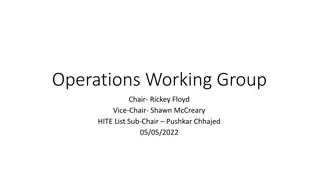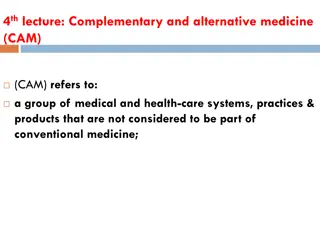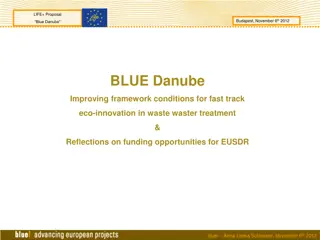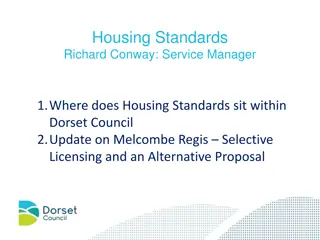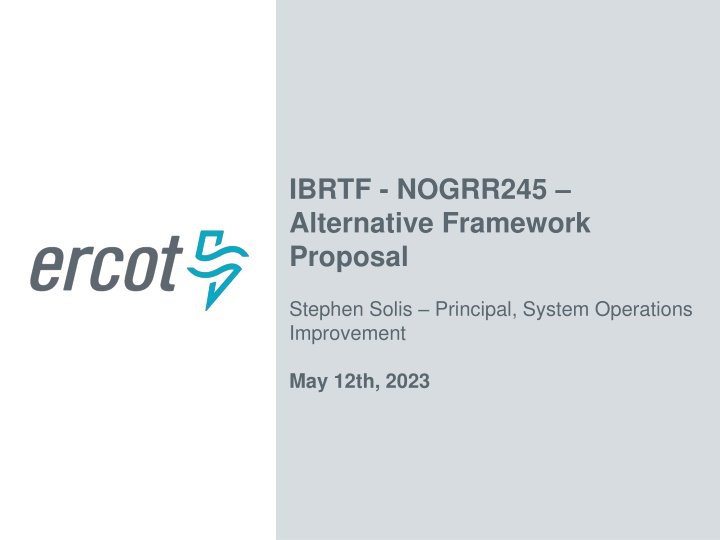
ERCOT Inverter-Based Resource Framework Proposal Overview
"Learn about ERCOT's alternative framework proposal to address issues with Inverter-Based Resources (IBRs) failing to ride-through disturbances. The proposal aims to align IBR ride-through requirements with IEEE standards and NERC guidelines to enhance reliability and prevent future performance failures."
Download Presentation

Please find below an Image/Link to download the presentation.
The content on the website is provided AS IS for your information and personal use only. It may not be sold, licensed, or shared on other websites without obtaining consent from the author. If you encounter any issues during the download, it is possible that the publisher has removed the file from their server.
You are allowed to download the files provided on this website for personal or commercial use, subject to the condition that they are used lawfully. All files are the property of their respective owners.
The content on the website is provided AS IS for your information and personal use only. It may not be sold, licensed, or shared on other websites without obtaining consent from the author.
E N D
Presentation Transcript
IBRTF - NOGRR245 Alternative Framework Proposal Stephen Solis Principal, System Operations Improvement May 12th, 2023
Overview ERCOT has experienced multiple events where Inverter Based Resources (IBRs) have failed to ride-through the disturbance. The magnitude of these events have increased as the levels of IBRs synchronized to the ERCOT System have increased. ERCOT received a recommendation as part of the 2021 Odessa Disturbance Report. ERCOT should ensure that the recommendations contained within the NERC reliability guidelines are comprehensively reviewed and adopted to ensure mitigating actions are put in place to prevent these types of issues in the future. Many of the performance issues in this event could have been mitigated if appropriate performance requirements were established for these resources and interconnection studies were performed to ensure conformance with those requirements EPRI gap assessment of IEEE 2800 vs ERCOT Protocols and Guides recommended that ERCOT improve Inverter Based Resource (IBR) Ride- Through requirements to align with IEEE 2800 ride-through requirements which could mitigate some recent failure mode causes. Feedback at ERCOT IBRTF was to prioritize ride through requirement changes over other changes. NOGRR enhances clarity and specificity of frequency and voltage ride through requirement sections for IBRs while aligning with most relevant IEEE 2800 standard and NERC Reliability Guidelines. 2 PUBLIC
Disclaimer ERCOT is presenting an alternative framework in an attempt to provide an alternative that considers stakeholder feedback while attempting to still mitigate the reliability risk imposed by IBR ride through performance failures. This presentation is meant to facilitate discussion and solicit additional feedback to determine if this framework merits the more extensive language changes necessary to accommodate them prior to making such changes. Nothing in this proposal is to be interpreted as a final position of ERCOT and ERCOT maintains the discretion to not support this framework based on feedback and additional information presented to ERCOT. 3 PUBLIC
IBR - Frequency-ride through (FRT) requirements Alternative framework proposes to move forward with the IEEE 2800 FRT requirements for all IBRs by 12/31/25 as drafted in the last ERCOT submitted comments for NOGRR 245 Feedback seems that these changes are feasible 4 PUBLIC
IBR VRT Framework Summary 12/25 5/23 12/31/25 maximize capability and comply with NOGRR 245 with current VRT curves NOGRR 245 passed All new IBRs comply with IEEE 2800 3/1/24 - Pre-2014 IBRs able to comply or retrofit? Pre-2014 IBRs 2014 2023 IBRs 2023 - future IBRs Must comply with current VRT curves and requirements Must comply with current VRT curves and requirements Must comply with IEEE 2800 curves and requirements 12/31/27 Pre-2014 IBRs that retrofit must meet IEEE 2800 curves and requirements 1/26 New and retrofitted IBRs Pre-2014 IBRs 2014 2024 IBRs Must comply with current VRT curves and new specificity from NOGRR 245 Must comply with current VRT curves and new specificity from NOGRR 245 Must comply with IEEE 2800 curves and requirements 5 PUBLIC
IBR Voltage Ride-through (VRT) requirements ERCOT is considering the following alternative framework: All new IBRs with signed Interconnection Agreement on or after NOGRR 245 approval must meet IEEE 2800 requirements to interconnect All existing IBRs with signed Interconnection Agreement before NOGRR 245 approval must maximize their current ride through capability to meet or exceed the current, in effect VRT curves (blue zone below) as soon as practicable but no later than 12/31/25. *No exemptions/ grandfathering. Includes all NOGRR 245 specificity but applied to the current VRT blue zone below only. All existing IBRs must install DFRs and PMUs if not already installed(IEEE 2800 Table 19) 6 PUBLIC
IBR Restrictions for performance failures Between NOGRR 245 effective date and 12/31/25: Any existing IBR performance failures vs the current, in effect VRT curves may have restrictions applied until the issue is mitigated Includes IBRs with current exemptions/grandfathering which must perform to the current, in effect VRT curves (i.e. exemptions are removed). Momentary cessation or poor/no reactive response is not allowed. By 3/1/24, any IBR that determines it cannot meet the current, in effect VRT curves with additional requirements in NOGRR 245 by 12/31/25, must identify if it plans to maximize the VRT capability and or retrofit after 12/31/25. Retrofit/replacement elections must meet the IEEE 2800 requirements and latest reactive capability requirements by 12/31/27 (e.g. GINR process). Retrofit/replacement election may continue to operate without restriction after 12/31/25 until 12/31/27 so long as the IBR continues the GINR process and does not have a ride through performance failure at which time restrictions may be applied. Restrictions may be lifted when the issues is mitigated to allow them to meet the current, in effect VRT curves. After 12/31/27, if the IBR has not completed its retrofit or cannot meet the IEEE 2800 requirements, it shall be restricted to the output that can meet the requirements. Any new IBRs after NOGRR 245 effective date must meet the IEEE 2800 requirements. 7 PUBLIC
IBR Restrictions for performance failures After 1/1/26 : All existing IBR performance failures vs the current, in effect VRT curves with NOGRR 245 specificity may have restrictions applied until the issue is mitigated After 1/1/28: Any IBR performance failures vs the IEEE 2800 requirements by retrofitted/replaced IBRs may have restrictions applied until the issue is mitigated. If the IBR did not completed its retrofit or cannot meet the IEEE 2800 requirements, it shall be restricted to the output that can meet the requirements. Any new IBRs after NOGRR 245 approval date must meet performance vs the IEEE 2800 requirements and may have restrictions applied for any performance failure until the issue is mitigated 8 PUBLIC
Additional considerations Alternative framework hinges on performance failure restrictions and removal of exemptions to allow additional time frames and reduction of requirements for the majority of existing IBRs. All IBRs will need to have PMU and DFR for performance validation during disturbances. Retrofit decisions must be made in early 2024 to allow for implementation time based on feedback and full GINR process. If any modifications resulting from activities such as retrofit/repowers are applicable to Planning Guide Section 5.2.1, IBRs will need to follow the GINR process and must meet IEEE 2800 and latest reactive capability requirements. Assumes all IBRs without exemptions can comply with the existing rules. Restrictions will clarify that if an IBR can comply with ride through requirements by limiting its maximum output, this would be an acceptable mitigation. Entities should not wait and should maximize ride-through capabilities as soon as practicable as more substantive changes will require model validation and studies prior to implementation (could take months depending on magnitude of changes). 9 PUBLIC
Questions? PUBLIC


